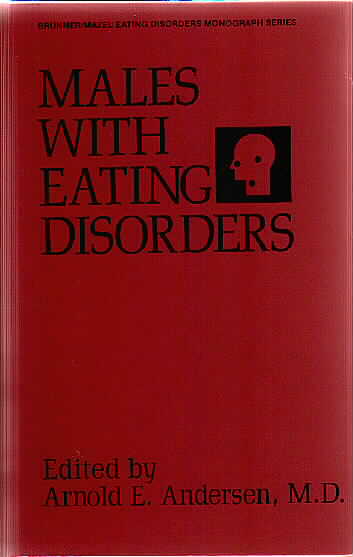 by Edited by Arnold E. Anderson
by Edited by Arnold E. Anderson
This is the first book to chart this seldom documented territory. It investigates the range of human needs that contribute to eating disorders, includes personal identity, body image, gender identity, gratification and impulsiveness, guilt, and even the physical demands of one's profession.
Full Description:
This is the first book to chart this seldom documented territory. It investigates the range of human needs that contribute to eating disorders, includes personal identity, body image, gender identity, gratification and impulsiveness, guilt, and even the physical demands of one's profession.
The subject of anorexia nervosa and, more recently, bulimia nervosa in males has been a source of interest and controversy in the field of psychiatry and medicine for more than 300 years. At times the very existence of this topic has been imperiled by theoretical dogma, despite the fact that the first two case reports on anorexia was a male. Recent trends in industrialized countries sharing an emphasis on the value of thinness suggest that these disorders may be increasing in males, perhaps altered in form from the typical presentation in women. The Goals of Mutual Aid Groups The ultimate goals of both naturally occurring and contrived support systems are the same as those of professional treatment: amelioration of deficiency and promotion of healthy development (Andersen, 1985: Pearson, 1983). However, with the exception of some "self-help" groups (e.g., Meehan et al., 1984), most mutual aid groups do not use "techniques" designed to produce immediate symptom reduction, structural personality change, and/or corrective emotional experiences in the realm of interpersonal interactions (Enright et al., 1985). Instead, the overriding goal of self-help/support groups is to teach members to provide themselves with the six major benefits of social support. More specifically, all mutual aid groups for people with eating disorders seek to (Enright et al., 1985; Kinoy, 1985; Meehan et al., 1984; Roback, 1984; Rubel, 1984): - Help participants overcome the withering effects of isolation induced by the disorder itself and by its negative impact on interpersonal relationships (companionship, emotional support, and status support);
- Provide a safe and caring atmosphere in which participants can experience, identify, express, and validate their feelings about the disorder, treatment, and recovery (emotional support);
- Foster within the group a spirit of accurate empathy, unconditional positive regard, and authenticity (Rogers, 1951) so that members can increase their self-esteem as they learn to be more flexible in their expectations of themselves and others (esteem, emotional, and motivational support);
- Help members understand and participate in the reciprocal relationship between personal empowerment and reaching out to others (esteem, motivational, and informational support);
- Help clients understand and adjust to the demands of "therapy" and improved health (motivational, informational, and esteem support);
- Educate participants about the nature, causes, and treatment of eating disorders (informational support);
- Emphasize that restrictive dieting, binge-eating, purging, and/or excessive physical activity are self-defeating and self-perpetuating "solutions" to personal problems (informational and emotional support);
- Provide some form of therapeutic support in the broadest sense for persons who have been harmed by inept physicians and therapists (see Garner, 1985), or for whom individual and specialized treatment is too expensive or too far away (emotional, esteem, and motivational support).
The Beneficial Processes in Mutual Aid Groups for Eating Disorders Although it is very important to distinguish between group therapy and group support, some of the "component processes" of group therapy (Yalom, 1975) are also active in self-help/support goups for eating disorders and for other psychological problems (Franko, 1987; Goodwin & Mickalide, 1985; Knight, Wollert, Levy, Frame, & Padgett, 1980; Leichner et al., 1985). Yalom (1975) refers to these processes as "curative factors," but we prefer to recognize their applicability to mutual aid groups as well as to therapy groups by calling them "beneficial group Processes." Table 1 portrays the connection between each of the beneficial group processes and the components of social support to which they contribute... Contents Include:- Section I: History, sociocultural studies, and psychological functioning
- Section II: Clinical and psychometric studies
- Section III: Treatment and outcome
- Section IV: Intergration
274 pages; 8 1/2 X 11;hard bound
Contributors
Preface SECTION I: HISTORY, SOCIOCULTURAL STUDIES, AND PSYCHOLOGICAL FUNCTIONING- Anorexia Nervosa in the Male: Early Historic Cases
- Joseph A. Silverman
- Male Bulimia Nervosa: An Autobiographical Case Study
- Ralp F. Wilps, Jr.
- Sociocultural Factors Influencing Weight Among Males
- Angela D. Mickalide
- Sexuality in Males with Eating Disorders
- David B. Herzog, Isabel S. Bradburn, and Kerry Newman
- Men, Body Image, and Eating Disorders
- Ann Kearney-Cooke and Paule Steichen-Asch
SECTION II: CLINICAL AND PSYCHOMETRIC STUDIES - Primary Anorecia Nervosa in the Male and Female:
A comparison of Clinical Features and Prognosis- Arthur H. Crisp and Thomas Burns
- Eating Disorders in Males: Insights from a Clinical and Psychometric Comparison with Female Patients
- D. Blake Woodside, David M. Garner, Wendi Rockert, and Paul E. Garfinkel
- Psychometric Testing in 76 Males with Eating Disorders
- David H. Edwin and Arnold E. Anderson
SECTION III: TREATMENT AND OUTCOME - Diagnosis and Treatment of Males with Eating Disorders
- Arnold E. Andersen
- Outcome of Anorexia Nervosa in Males
- Thomas Burns and Arthur H. Crisp
- A Professionally Led Support Group for Males with Eating Disorders
- Michael P. Levine, Trent A. Petrie, Jerome Gotthardt, and Todd D. Sevig
SECTION IV: INTEGRATION - A Proposed Mechanism Underlying Eating Disorders and other Disorders of Motivated Behavior
- Arnold E. Andersen
Subject Index
Name Index
In-Stock- Orders received before 4pm EST will be shipped the same business day!
|